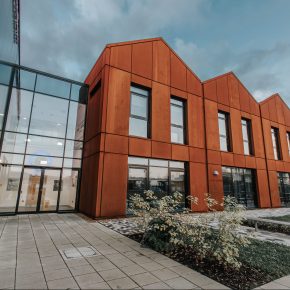
Impact of BIM on collaboration and in resolving project conflicts
BIM and its Role in Dispute Resolution and Collaboration
BIM and its role in dispute resolution and collaboration
Article for BUILDINGTALK by Martin Penney of Technics Group
Building Information Modelling (BIM) is a term that you are sure to have heard many times before – it continues to be a hot topic of discussion within the industry. One thing is for sure: the multi-dimensional tool software, which also acts as a methodological process of collaboration and refinement to allow efficiency gains, is going to have a major impact on how we do things. In fact, it already is having a big impact on how we work in the industry.
Obstacles remain though and could best be described as a lack of understanding and fear of change. Existing processes are being threatened and the structure of the industry will need to undergo transformation – but thats not a bad thing. When we look at the benefits of a more integrated and efficient industry, whats not to like.
But what about dispute resolution and the role of BIM – could the tool create a more collaborative approach, to prevent these disturbances?
We take a closer look
Causes of disputes
Project disputes are normally the result of disagreements over the interpretation of information – which is not surprising when we consider there can be a huge volume of information and complex technical data to assimilate and comprehend. Add to this the task of sequencing, calculations and maintenance schedules, and youre left with something that can often be difficult to fully comprehend.
It seems only natural that we would search for a method of making this information and data more understandable, transparent and trustworthy. BIM can make this a reality by creating a more positive, factual and iterative-solution based philosophy.
But it needs to be accompanied by personnel within the industry who have the desire to do away with the mentality of us-and-them that still exists to this day.
A look to the past
If we look at the industry from the historical perspective of a surveyor, their role would mainly be in the early stages of a project. This would normally involve the creation of 2D or 3D topographic and measured building surveys. Following this would be construction designs, and in some cases, as-built internal and external drawings towards the later stages of construction. This leaves the surveyor practically disconnected from the full build process.
The science and techniques largely remain the same, but modern technology and software mean that the surveyor now operates closer to the end-user. This allows them to contribute directly and significantly (to BIM) through the utilisation of visualisation packages for a more collaborative approach. Sharing this information will help to prevent problems at the later stages of construction by getting them closer to the heart of the design.
Closer to the process
BIM is about aiding the process through transparency and so it makes sense to have the surveyor conduct regular re-surveys during construction. This will lead to a more accurate as-built BIM and maintain a record of the construction which is built up layer by layer. Why would we need this information and data to be updated? Because, as you will know, these things are rarely built exactly to design.
This ability to update BIM with vital information as work progresses and have the building virtually pre constructed creates a more collaborative approach for the different personnel involved in a build. This allows projects to develop more smoothly and helps to reduce the occurrence of disputes by assisting construction.
Facilities management
If we move on to this stage of a project where the client focus is on making sure they are getting what they want and not something that merely looks good, the role of BIM as a collaboration tool is essential. This is because handing over accurate up-to-date data and models with the correct structural dimensions and features is crucial.
BIM makes this a smooth process and once again helps to prevent disputes by providing a greater level of collaboration. The aim is to have a constantly evolving project that will run through the entire lifecycle of the building and provide a more inclusive approach. Having this timely and accurate data on hand will also make getting to the heart of any disputes much easier.
Co-operation means fewer disputes
BIM is a tool that has the potential to have a massive impact on the future of the construction industry, but it will still rely on collaboration from all levels of a project. This makes the roles of surveyors, management and other personnel vitally important in sharing timely and accurate information.
The human factor remains vital though as the data will still need to be understood and interpreted. This means that the data added to a BIM project must be accurate – especially where instances of disputes do occur and need to be resolved.
This is not a white knight that is going to save the construction industry or the key industry driver for change – thats simply getting slick and working together to save costs. But it is coming and will proliferate, which is the key point.
Article for BUILDINGTALK by Martin Penney of Technics Group
Latest news

13th March 2025
Vent-Axia Publishes Free eBook to Help Social Housing Landlords Navigate Awaab’s Law
Leading British ventilation manufacturer Vent-Axia has published a free eBook, ‘Ensuring Safe Housing Conditions: Focusing on Mould and Damp Conditions’.
Posted in Air Conditioning, Articles, Building Industry News, Building Products & Structures, Building Regulations & Accreditations, Building Services, Damp & Waterproofing, Facility Management & Building Services, Health & Safety, Heating, Ventilation and Air Conditioning - HVAC, Innovations & New Products, Publications, Research & Materials Testing, Retrofit & Renovation
13th March 2025
First Processing Industries apprenticeship completed within West Fraser
West Fraser is pleased to announce that the company’s continued investment in apprenticeships, as well as wider staff development training, has seen one recruit successfully complete his modern apprenticeship.
Posted in Articles, Building Industry Events, Building Industry News, Building Products & Structures, Building Regulations & Accreditations, Building Systems, Recruitment, Restoration & Refurbishment, Retrofit & Renovation, Timber Buildings and Timber Products, Training, Walls, Wooden products
11th March 2025
ADSA’s 40 Years of Innovation
The Automatic Door Suppliers Association (ADSA) is kicking off its 40th anniversary with the launch of an animated timeline that showcases its incredible journey and industry-defining achievements.
Posted in Access Control & Door Entry Systems, Architectural Ironmongery, Articles, Building Associations & Institutes, Building Industry Events, Building Industry News, Building Products & Structures, Building Services, Doors, Facility Management & Building Services, Health & Safety, Innovations & New Products, Recruitment, Retrofit & Renovation, Security and Fire Protection, Training, Videos
11th March 2025
Senior answers the call at Merseyside’s new state-of-the-art fire station
Safe, secure, and sustainable aluminium fenestration solutions from Senior Architectural Systems have been installed at Merseyside Fire & Rescue Service’s brand-new fire station in Aintree.
Posted in Aluminium Products, Articles, Building Industry News, Building Products & Structures, Building Systems, Case Studies, Curtain Walling, Doors, Facades, Glass, Glazing, Restoration & Refurbishment, Retrofit & Renovation, Sustainability & Energy Efficiency, Walls, Windows
 Sign up:
Sign up: